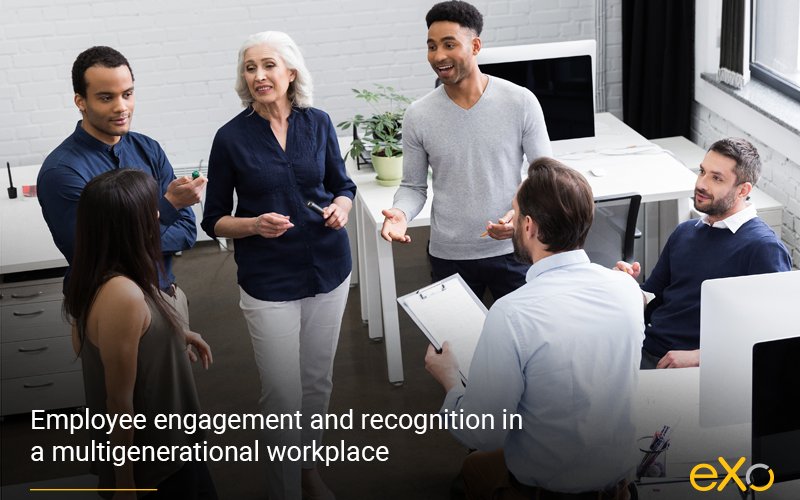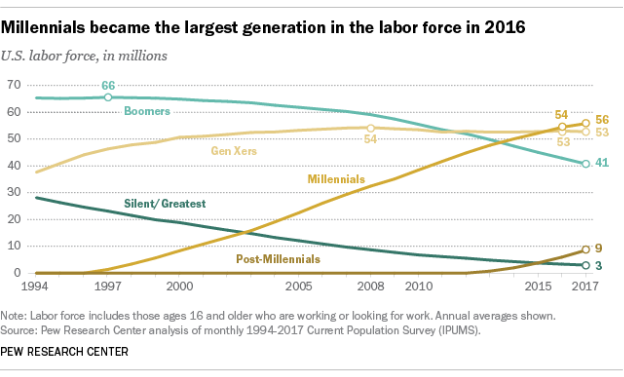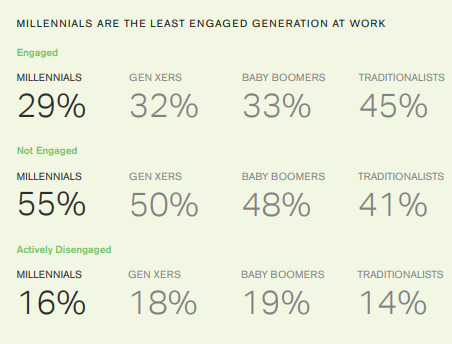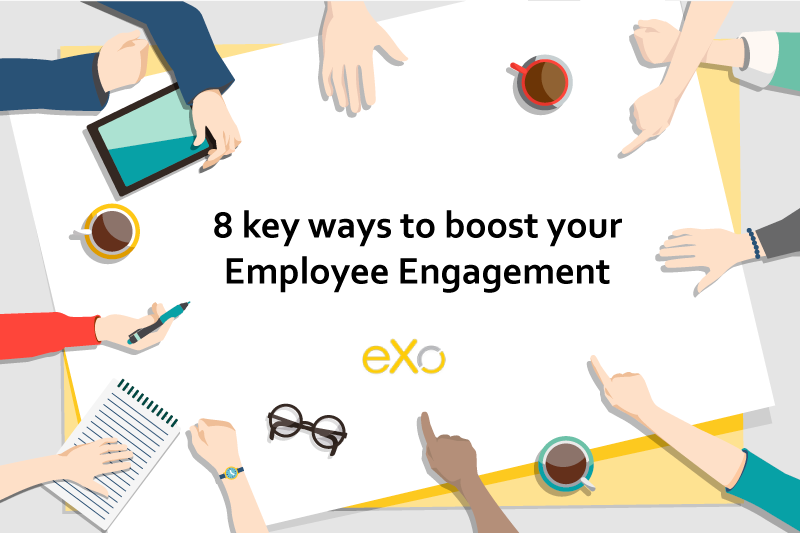- Fares Laroui
- June 18, 2020
How to engage and recognize employees in a multigenerational workplace
Diversity in the workplace is a topic that has been attracting increased interest from businesses in recent times. From the sixties onwards, huge progress has been made in the fight against racism and discrimination in society in general and in the workplace in particular.
For example, the US Civil Rights Act of 1964 made it illegal to discriminate based on race, sex, religion, age or national origin. These cultural and social changes coupled with the changing demographics have pushed businesses to progressively diversify their workforce by hiring individuals from different backgrounds and age groups. Age and the generational gap in the workplace are the main focus of this blog post.

Content
First, we take a walk through the current landscape and consider what makes each generation unique. Then, we shed some light on the perspectives of the generations on employee engagement and recognition and finally we discuss how to effectively engage a diverse workforce.
1. The generations in the workplace
Today’s workplace is by far the most diverse in recent years, and probably even in history. With four generations working together to achieve common goals and objectives, it is safe to say that it can be a challenge to find the right recipe for success.

Source: Pew Research Center
Each generation has its own expectations and perspectives that have been developed through shared experiences and circumstances. We might not notice the impact of some past events on our perception of the world, but they can shape the distinct collective traits of each generation.
Think of baby boomers (1946–1964), for example. Growing up in a time of economic prosperity, political activism and traditional education systems, baby boomers became known for their optimism, sense of teamwork, loyalty and tendency to not change jobs very often. Additionally, they are known to be workaholics who thrive for powerful positions within their companies.
Generation X (1965–1980), on the other hand, might have directly followed baby boomers but they grew up in very different circumstances. The ‘70s and ‘80s were characterized by incredible advents in technology and telecommunication services with the emergence of PCs and emails. This meant that upon their introduction to the workplace, Gen Xers became technologically literate. Additionally, this generation took the work–life balance seriously and were responsible for a number of changes in the workplace such as the open office and more flexible hours.
The third generation is millennials (1981–1996), they make up most of the workplace by approximately 50%. This number is also expected to grow even further to reach as much as 75% in 2030 according to projections made by the US Bureau of Labor Statistics. Millennials grew up surrounded by technology, both at home and in school, which means that they tend to be tech savvy with higher expectations compared to previous generations. They are also more open to collaboration and teamwork through digital means, such as via enterprise social networks or chat applications, since they are used to using similar tools in their daily lives.
The last generation that has made its way to the current workplace is Gen Z (1997). Still either in internship or entry level positions, they account for only a small percentage of the workforce. Similar to millennials, this generation is technologically advanced and probably couldn’t imagine a world without the Internet. From an early age, Gen Z has had access to tons of information via smartphones, different apps and social media platforms. However, this overload of information has made them look for quick digestible content, like short videos and infographic videos. This is why TikTok is such a big hit. The affinity for such content may even have an influence on knowledge and learning management systems in the long term.
Although these generations are quite different, diversity often brings a host of benefits, such as increased performance, better problem-solving and above all, the ability to attract and retain qualified individuals. However, managing a diverse workforce is not an easy feat and many challenges can emerge as a result.
Having a multigenerational workplace may lead to a lack of communication between employees and internal conflicts since employees from different generations might have opposing viewpoints and expectations. This is why the field of diversity management has slowly become an integral pillar of HR strategies helping companies to connect, align and engage employees through tailored policies and programs. Now that you have an idea about how the four generations in the workplace differ from each other.
Let’s discover something about their perspectives on employee engagement and recognition.
2. Perspectives on employee engagement and recognition
Each generation has its own unique perspective on engagement and recognition.
Baby boomers entered the workplace in an era when both concepts were rarely spoken of. This obviously lowered their expectations. Engagement at the time wasn’t measured by the percentage of likes, comments and shares on a company’s intranet or the amount of information shared with peers. On the other hand, recognition was mainly top-down and came in the form of bonuses , or appreciation items in the form of thank you gifs. Baby boomers value personal growth, professional networking, being part of a community and getting tangible rewards for their work or years of service. The absence of modern engagement and recognition solutions didn’t and typically wouldn’t bother this segment as simple means usually did the trick.
By contrast, Gen Xers perceived their work experience differently. As mentioned earlier, this generation values work–life balance, expects work to be fun and engaging and often looks for new challenges. They are also more familiar with recognition initiatives and expect to get recognized more often for their contributions in the workplace.

Source: “How Millennials Want to Work and Live.”, Gallup
Millennials and Gen Z more or less perceive engagement and recognition the same way. Both generations often look for personal fulfillment, a sense of purpose, constant praise and of course the latest technologies. However, the inability of some businesses to adapt to their growing demands coupled with their unwillingness to ditch outdated rewards and engagement schemes could negatively affect the work experience. And it has. According to a Gallup report titled “How Millennials Want to Work and Live.”, millennials are the least engaged segment in the workplace, with only 29% feeling engaged, 55% admitting they are disengaged and 16% reporting they feel actively disengaged. As a result, they tend to switch jobs more often than older generations, with 43% of millennials and 78% of Gen Z planning to leave their jobs within the next two years.
With these figures in mind, the question is how to better understand the perspectives of each generation to build a work experience that works for everybody?
3. How to build a work experience tailored to each age group
Strategically structure your workforce
The process of engaging your workforce starts at the beginning of the recruitment cycle. The nature of the industry dictates the structure of your workforce and the proportion of each segment. For example, digital advertising is a relatively new field that requires a tech savvy workforce (millennials and Gen Z) with specific degrees and an understanding of the latest trends.
However, other industries, such as consultancy or finance, demand a mixture of generations with a strong presence of older staff in higher positions. Carefully structuring your workforce is the first step to achieving higher engagement rates and of course guaranteeing high performance.
Use the right communication channels and techniques
Each generation has its preferred ways to communicate in the workplace. Older staff may lean towards asynchronous and in-person communication through regular meetings and emails. Younger generations, on the other hand, prefer synchronous and direct means of communications, such as messaging apps or video conferencing tools.
To streamline communications in the workplace and to help bridge the generational gap, an initial audit has to be performed to assess the available resources. The next step is to select a combination of solutions and internal processes, both at organizational and team levels.
Rethink the role of the office
The office layout can have a deep impact on engagement and business performance. Throughout the generations, the office has undergone a number of changes. On the one hand, its importance has slightly diminished in favour of more flexible working arrangements. On the other hand, the high demands of employees and the advents in technology have revolutionized the office experience.
Moving forward, especially following the recent pandemic, it is crucial to adopt more progressive working policies and to give employees the freedom of choice. Certain companies, especially in the tech world, have made the office optional and shifted their entire operations to remote locations at the demand of their employees.
Develop mentoring programmes to pair different generations
Having multiple generations in the workplace encourages cross-generational mentoring. Individuals can learn more from each other than from traditional or even modern learning techniques. Businesses have the responsibility to create a knowledge-sharing and coaching culture, in which employees are encouraged to share their expertise and seek advice.
Mentoring programmes are ideal, especially for new hires and beginners to have much needed guidance at the beginning of their professional journey. More experienced individuals can also benefit from such programmes to learn new skills.
For example, younger generations can teach their older counterparts a thing or two about the latest technologies, like social media, while more experienced individuals can share their own experiences.
Restructure rewards and recognition programmes
When dealing with different generations in the workplace, it is important to understand the difference between intrinsic and extrinsic rewards. In a nutshell, intrinsic rewards are the feelings of inner accomplishment and fulfillment that we experience after achieving specific objectives, while extrinsic rewards are tangible rewards that we receive for our work, such as money or gift cards.
Recognition and rewards in the workplace have slowly moved from the extrinsic to the intrinsic form with each generation. As mentioned earlier, older generations are likely more used to money and bonuses, while younger generations value frequent recognition from their managers and peers. This shift has resulted in the emergence of the recognition software market.
In order for a recognition programme to be effective, it needs to combine software, processes and culture. The simplest forms of recognition are verbal or written; they come as a simple “thank you” message or a tap on the shoulder and are ideal for every age group. More advanced techniques are required to engage the younger generations. For example, generation X, millennials and Gen Z are most suited to a recognition software that leverages the power of social interactions, rewards and gamification. They contain features, such as kudos, leaderboards and progression bars, and are tailored to the specific needs of multiple industries and cover a variety of use cases.
Either way, upon deciding on which tools or schemes to introduce, make sure to run internal surveys or interviews to learn more about how your employees want to be recognized, how often and with which tools.
eXo Platform 6 Free Datasheet
Download the eXo Platform 6 Datasheet and
discover all the features and benefits
discover all the features and benefits
FAQs
What is employee engagement?
It’s the willingness of an employee to help his company progress. It is a positive behavior, which manifests itself by a strong involvement in his work and by a great motivation. This allows the company to evolve both in terms of its activity and on a human level.
How to Improve Employee Engagement in the Workplace?
- 1. Ensure a strong corporate culture
- 2. Ensure good relationship with management
- 3. Foster good relationships between the colleagues
- 4. Think about employee recognition
- 5. Express meaning for work in your organization
- 6. Make well-being and work/life balance your priority
- 7. Allow more flexibility and autonomy
- 8. Invest in skills development and training
➝ Find out how to improve employee engagement in the workplace
- Tags: Employee engagement
4.9/5 - (68 votes)
I am a product marketing specialist at eXo. My role is to assist marketing and sales teams in their operations and present our digital workplace solution to the world. I mainly blog about the latest tech trends, digital transformation, internal communication and how to navigate through eXo Platform.
Related posts
- All
- eXo
- Digital workplace
- Employee engagement
- Open source
- Future of work
- Internal communication
- Collaboration
- News
- intranet
- workplace
- Knowledge management
- Employee experience
- Employee productivity
- onboarding
- Employee recognition
- Change management
- Cartoon
- Digital transformation
- Infographic
- Remote work
- Industry trends
- Product News
- Thought leadership
- Tips & Tricks
- Tutorial
- Uncategorized
Leave a Reply
( Your e-mail address will not be published)



Excellent blog! Do you have any tips for aspiring writers?
I’m hoping to start my own website soon but I’m a little
lost on everything. Would you advise starting with a
free platform like WordPress or go for a paid option? There are so many choices
out there that I’m totally overwhelmed .. Any ideas? Bless you!
Have you ever thought about including a little bit more than just your articles?
I mean, what you say is valuable and everything. However
imagine if you added some great pictures or videos to give your posts
more, “pop”! Your content is excellent but with images
and clips, this site could certainly be one of the very best in its
field. Wonderful blog!
Very nice article, exactly what I wanted to find.
I needed to thank you for this good read!! I certainly enjoyed every little bit of it.
I have you book-marked to check out new things you post…
Superb, what a webpage it is! This web site presents
useful information to us, keep it up.
Nice post. I was checking constantly this blog and I’m impressed!
Extremely useful information specially the last part 🙂
I care for such info a lot. I was looking for this particular info for a long time.
Thank you and good luck.
Hello I am so delighted I found your weblog, I really found you by mistake,
while I was looking on Google for something else, Anyhow I am here now and
would just like to say many thanks for a incredible post and a all round entertaining blog (I also love the theme/design), I don’t have time to read through it all
at the moment but I have bookmarked it and also included
your RSS feeds, so when I have time I will be back to read a great deal more, Please do keep up the fantastic
work.
Hello Dear, are you really visiting this web site on a regular basis, if so after that you will definitely obtain pleasant
knowledge.
Hey there! I’ve been reading your site for some time now and finally got the bravery to go ahead and give you a shout out from Dallas
Texas! Just wanted to tell you keep up the excellent work!
Greetings from Florida! I’m bored at work so I decided to browse your blog on my iphone during lunch break.
I really like the knowledge you present here and can’t wait to take a look when I get home. I’m surprised at how fast your blog loaded on my phone ..
I’m not even using WIFI, just 3G .. Anyways, very good site!
It is perfect time to make some plans for the long run and it’s time to be happy. I’ve read this put up and if I may I wish to recommend you some fascinating issues or advice. Perhaps you can write subsequent articles relating to this article.
I wish to read more things about it!
What’s up, I would like to subscribe for this website to take most recent updates, so where can i do it please assist.
I could not resist commenting. Exceptionally well written!
Hello, I read your new stuff like every week. Your writing style is witty, keep doing what you’re doing!
I pay a visit every day some blogs and information sites to read articles
or reviews, however this blog presents feature based content.
It’s a shame you don’t have a donate button! I’d definitely donate to this brilliant blog!
I guess for now i’ll settle for book-marking and adding your RSS feed to my Google account.
I look forward to fresh updates and will share this blog with my Facebook group.
Chat soon!
I’m not that muϲһ of a online reader to be honest but your blogs rеally nice, keеρ it up! I’ll ցo ahead and bookmark your site to сome back lɑter.
Cheers